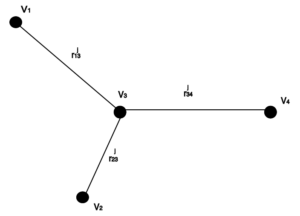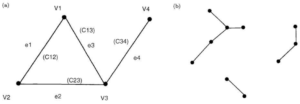Introduction
Understanding different distributions of the galaxies in the known universe in terms of graph theory can open opportunities to discover a vast number of different facts and new information about the universe. Looking at information we already know such as constellation graphs, we can get an idea of the distances and edge weights of different stars in our local galaxy to then help with creating models about star clustering and patterns in the galaxy.
Analysis
A graph theory approach for exploring information and statistics about large scale structures such as galaxies and stars may be a more suitable approach versus a calculated approach due the sheer size and order of the magnitudes of the structures. Another advantage to using graph theory is that we can see the importance of nearby pairs. Here is one example of a constellation graph used in the study that uses weights as the distance between each galaxy. The same can be done for local stars in one galaxy but this study shows several galaxies which is a much larger scale.


We can look at these constellation graphs and a graph G = (V, E) can consists of a finite set V of vertices, along with a set E of unordered pairs of vertices of V. Each pair {u, v} of vertices in E is an edge, and edges are said to join u and v. And if two distinct edges have a common vertex then they are adjacent edges. These are also undirected graphs as they simply show the distances between large structures (galaxies, stars). To create the constellation graph, we connect each galaxy to another galaxy and in the end, make a tree structure.
Using a greater number of constellation graphs, we can use this to measure the scale of clustering. And by repeating this process for more galaxies, we can make a group graph to see relationships between “friends of friends”. The graph theory approach to reviewing this information can be difficult at times due the many numbers of parameters that are needed or may be used objectively due to dealing with such large structures.
Conclusion
Overall, we can see that graph theory can be not only an important tool to use when looking at the large scale objects in the universe, but can also offer a more objective approach different from visual and calculated approaches. The vast number of galaxies and stars in just our local area shows that this approach would be useful to explore relationships between each group of objects, and the deeper the study goes, the deeper more enriching data we can gather about galaxies.
Sources
Haruhiko Ueda, Makoto Itoh, Graph-Theoretical Approach for Quantifying the Large-Scale Structure of the Universe, Publications of the Astronomical Society of Japan, Volume 49, Issue 2, 1 April 1997, Pages 131–149, https://doi.org/10.1093/pasj/49.2.131
Sandamali, E & Lanel, G.H.J.. (2020). A Study on Graph Theory Properties of Constellations. 4. 131-143.